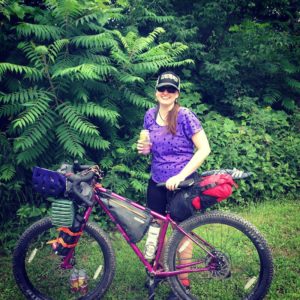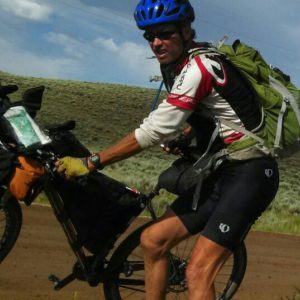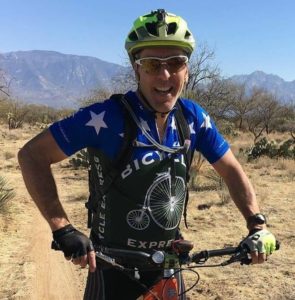Vermont Bikepackers is hosting their 2019 Super 8 Grand Depart on September 28th! We tracked down Danielle Blanca, Jeff Mullen, and David Tremblay, all members of Vermont Bikepackers, to get their tips and tricks as they prepare for their ride.
What do you pack? What do you leave behind?
DB: Pack the essentials, anything that will keep you going and warm enough/cool enough. You have to haul around what you bring on your bike – think of what you want to haul up a steep class IV road, did you really need that third tech shirt? Don’t pack your fears! You are bikepacking, it isn’t pretty and don’t worry about how grungy you are. If you aren’t covered in mud, sweat, grease and potentially a little blood- you’re not doing it right. Be smart: this is Vermont, there can be cold nights and mornings, warm days and whatever weather Vermont decides to throw at you. Bring a rain jacket, because if you don’t – it DEFINITELY will rain. Bring whatever will keep you alive if you are stranded out in the middle of nowhere with a mechanical or an injury – and always plan that you may come across someone with a mechanical or an injury and they may need help, which may take a few hours. I cannot stress enough that you need to practice riding your loaded bike before heading out on an overnight. Load up your bike and just ride around your town and bring tools to make adjustments to make your rig more comfortable. You will be riding 6-14 hours depending on your route and plan, you need to be comfortable and dial in how you will haul your loaded bike over blow downs, fences, river crossings etc. Read product reviews, read about other people’s pack lists and kits, use social media to your advantage! I am constantly on Bikepacking.com and I love listening to Bikes or Death Podcast – there are a lot of bikepackers that want to get people on bikes. Don’t ever be intimidated to ask questions, the bikepacking community is pretty rad!
JM: I used to bring a small tent but now use a bivy unless it is a long event and/or a lot of foul weather is expected. Along with sleeping bag and pad. Enough warm/dry clothes to handle expected conditions which includes an extra pair of shorts/shirt/socks. Extra tube or 2 along with bike tools. A little bit of food and a music player is a must for those mentally tough sections (where no traffic too). Plus a few small incidentals like sunblock, chamois cream, toothbrush/paste, sunglasses. Fairly light but enough gear to be confident and comfortable.
DT: I pack as little as possible – which turns out to be too much. I did learn this year that – if tired enough – I can sleep on dirt in my wet bike clothes with no sleeping bag, pad, or tent! I leave behind the cooking setup – cold food only. And really try to not wear a backpack to keep the weight off the saddle.
How do you charge your lights/phone?
JM: I use a K-Lite (cockpit mounted) that is powered by my dyno hub (this has been awesome but is starting to have issues) along with a battery powered helmet light to turn on when I need to look at the GPS (carry a few extra batteries for this). I try to avoid using the phone much but might check trackleaders towards the end of the race and often take a few pics when things are exceptionally beautiful or unique. So I hope to not need to charge the phone.
DB: I have a portable battery pack, weighs about 1 pound, but I can charge my cell phone 4 times and my lights about 4 times, which is good for a few days. I would also suggest a dynamo hub as well for lights. Do your research before purchasing and find a really good bike shop/fellow bikepacker that has experience installing dynamo hubs, as they should be proficient with electronics – if they are not go somewhere else. I have heard way too many stories of bikepackers solely dependent on their dynamo hub for power and it fails them due to bad connections. Your bike is getting thrashed around riding and there are so many ways that your dynamo could potentially fail if it is not installed properly. Try to be involved in the installation process so that you can learn how it is connected so that you can fix it in the field.
DT: portable charger attached to a generator hub.
How do you navigate?
DB: Good ol’ fashioned maps and my phone (Strava or Map My Ride). I am still in the market for a Bike Computer and am leaning towards the Garmin Edge 520 Plus, but still been doing lots of research in forums/social media before purchasing.
JM: 6+ year old Garmin Etrex 30. I tried using maps and cues in my first event and that was difficult!
DT: Garmin Edge with iphone back up
What is your favorite tire for bikepacking in VT?
DB: A 2.2-2.4” if you are going to be hitting up some Class IV, make sure that there are some decent tread blocks on the edges of the tire, but also closely spaced center knobs on the rolling surface for the less gnarly terrain. The Panaracer Gravel King is tried and true and used by lots of Bikepackers.
JM: Whatever is currently on my bike! I’ve used Maxxis Ikon’s and Maxxis Ardent along with Continental Race Kings and have been happy with all of them.
DT: old bald mt bike tires!
What has been your worst moment/lowest low?
DB: I’m on a bike- how can I have a worst moment/low?! But- if I had to pick one, it was probably switching up my chamois butter on day 2 of 4 on the Green Mountain Gravel Growler, bad idea. It was made for women, so I thought it would be better- nope!
JM: The morning I woke up 1/3 of the way through the Great Basin (in the Tour Divide) and realized that my rear tire was flat and I most of my water had drained out of my hydration pack comes to mind. Along with the couple times that I struggled with serious saddle sores. For the most part I’ve always had good luck and have kept things on an even keel so no major lows. Knock on wood…
DT: Worst moments are lightning in Colorado and a tornado during TNGA – Many lows on the Tour Divide in 2010 – still processing this many years later.
How do you find a good resting spot or campsite?
DB: Wherever isn’t posted “Private Property” and is flat and doesn’t look like you may be harassed by neighbors or law enforcement. I typically find my site around dusk and leave around 5am, this typically removes the threat of being harassed or in someone else’s land. Be a steward of the land and pack in and pack out!
JM: I just start keeping my eyes open for a comfortable spot to sleep when it is that time. Public parks, athletic fields, grassy clearings, etc. have worked well. Campgrounds have often worked well also as they have bathrooms and picnic tables make for a nice flat/clean spot to lay out the bivy. In/out before anyone knows you are there.
DT: I’m not camping – I’m napping!
What is unique about bikepacking in Vermont vs. bikepacking in the American West?
DB: Vermont doesn’t have as much public use areas (BLM land) as the west and it can make it hard to find a good stealth camp site- which is my preferred way to camp. Also, Vermont is wet as opposed to the West, so you will need to plan out how to dry out your gear. I highly recommend a mid-day siesta to bring out your tent and hang it out to try, your sleeping bag, wet clothing etc. This is also a great time to take off your chamois for a little bit too! Let the skin breathe!
JM: More varied terrain than many events. I expect the Super 8 will be one of the toughest events that I will ever do due to the rough sections and steep climbs.
DT: The beauty is so up close and needs to be experienced – a bicycle is a perfect way to do this… not like out west where anyone can snap a photo and capture it!
About the contributors:

Danielle Blanca (Waterbury, VT) is a member of Vermont Bikepackers. She has completed multi-day tours of the Green Mountain Gravel Growler and the Véloroute des Bleuets in Canada. This from Danielle: “I originally was introduced to bikepacking many years ago through Mike Dion’s movie about the Tour Divide, Ride the Divide, but I was not a great mountain biker at the time so I was super intimated to go bikepacking and I never gave it any thought until a few years when I was re-introduced to mountain biking through winter fat biking. Through cycle touring I gained some basic mechanical skills to work on my bike, I also attended some basic maintenance workshops at Old Spokes Home in Burlington, VT which also was very helpful in learning more about different types of bikes and components. Between becoming more comfortable cycling on trails in remote places and having some mechanical aptitude I knew that bikepacking was the way to go! I feel pretty lucky here in Vermont to have so much access to gravel roads, Class IV roads and singletrack trails to make the bikepacking possibilities here endless with some creativity and grit. I am currently getting ready to ride the first +/- 1,000 miles or so of the Tour Divide next summer and will be also racing in the Super 8 next fall!”

Jeff Mullen (Richmond, VT) is a longtime member of Vermont Bikepackers. This from Jeff: “The Super 8 will be my 14th grand depart (seems appropriate since VT was the 14th state to join the union!) and I’m super psyched to be doing one where I can sleep in my own bed before and after, and where I’m familiar with much of the route. I’ve done GD’s in VA/WV, FL, GA, ID, NY along with Canadian events in Ontario, Alberta and BC (and the multi state/province Tour Divide). You learn more every time out and things definitely evolve.”

David Tremblay (Moretown, VT) has been mapping routes in Vermont for >20 years and served as one of the first directors of VMBA. Currently he serves on the board of directors of the Vermont Bikepackers. His ultra experience includes PBP ‘07, TD ‘10, and TNGA ‘11, and too many attempts at the XVT Bikepack Route to list.
